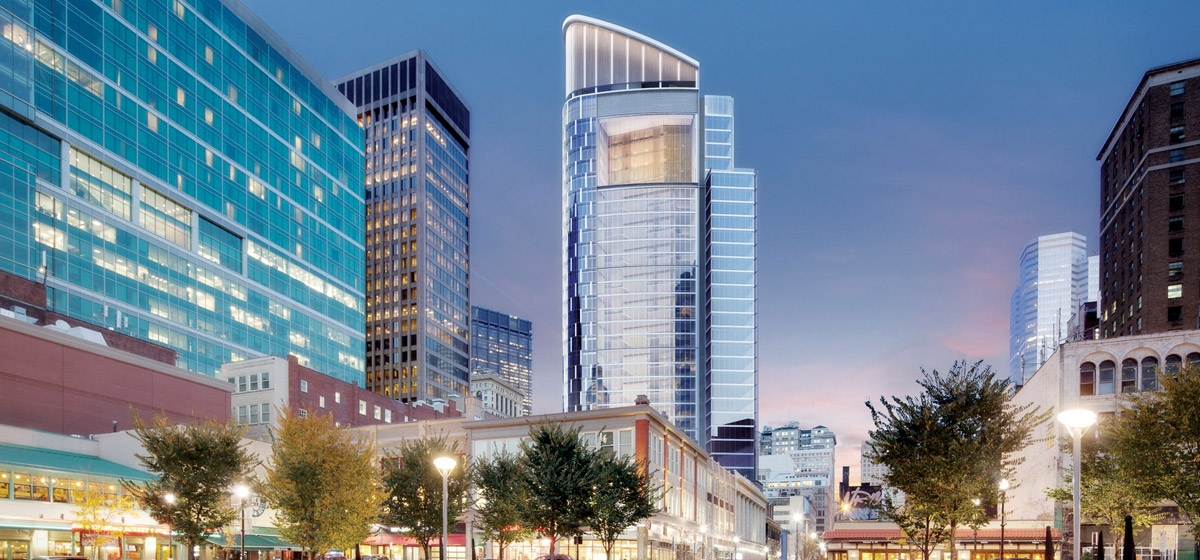
I was dining the other night at Poros, the fourth Downtown restaurant opened by Yves Carreau. The elegant new space connects PPG Place and Market Square, and as I watched passersby outside the wall of windows, I was struck by how much Pittsburgh has changed. Soon the ice rink at PPG Place will reopen and Market Square will become a Christmas market. Downtown is alive.
Twenty years ago, it was very different. I had started a regional benchmarking project at the Post-Gazette (now PittsburghToday.org) comparing Pittsburgh with other regions, and about the only things we had going for us were a thriving arts scene, low crime, and, because of our weak economy, very little traffic congestion.
I was also in charge of the newspaper’s development coverage, and the big story in 1997 was Mayor Tom Murphy’s “Fifth and Forbes” project. Back then, Murphy was the only local leader taking the initiative, and when developers wouldn’t risk money on Downtown, Murphy stepped into the breach.
His plan was to remake Downtown by tearing down some 60 buildings, hiring a developer and bringing in big-name national retailers, of which the anchor was to be Nordstrom. The mayor couldn’t contain his enthusiasm as he walked down Fifth Avenue with our reporter, making explosion sounds as he pointed to the buildings that would come down, largely through eminent domain.
Our job was to report the news, not opine about it. But with Pittsburgh mired in a slow and grinding decline, I saw Murphy’s plan as a candle in the darkness. Like Petula Clark’s great song, “Downtown” might again be the place “where all the lights are bright” and where people would come to shop, dine and maybe live, too.
The most ambitious parts of the $500 million plan, which was to include $100 million in public subsidies, collapsed in controversy. It was opposed by historic preservationists and local citizens, who alternately objected to wiping out old buildings and taking private property through eminent domain. A few parts, however, came to be: construction of a Lazarus department store and turning the historic Mellon Bank headquarters into a Lord & Taylor. Both failed in relatively short order.
The immediate aftermath was that many store proprietors who had expected their properties to be taken by the government either closed their businesses or moved. And the Fifth and Forbes district largely fell asleep for more than a decade, slowly becoming worse than it had been before the announcement of the doomed grand plan.
One of the benefits to living somewhere for a long time is that you see the sweep of change. In our case, the downs and the ups. The dark clouds finally dissipate and the sun shines again. And so it is with Fifth and Forbes.
Looking back, aside from ruining the once-magnificent Mellon Bank building—“the cathedral of earning”—the legacy of Murphy’s gambit is in the eye of the beholder.
Market Square has become a pedestrian-friendly gathering spot, with city buses banished and the Piatt family turning the old G.C. Murphy’s into residential space. More than 12,000 people live Downtown now, and that number continues to grow.
Point Park’s ambitious rejuvenation of its part of Downtown has spilled into Fifth and Forbes with a beautiful new Pittsburgh Playhouse scheduled to open in 2017.
And PNC, which not too long ago was generally seen as a takeover target, emerged from federal oversight to be a pillar of squeaky-clean financial strength just as the Great Recession wiped out other banks. After taking over Cleveland’s National City and acquiring other banks, PNC has become the country’s sixth-biggest bank. It’s had its own Downtown construction boom, including Three PNC Plaza (home of the Fairmont Hotel) and the Tower at PNC Plaza.
The Tower has been described as the defining skyscraper for this era in Pittsburgh, and with its focus on using the best sustainable practices and its litany of sustainable features, it’s destined to become the standard for sustainable urban construction. In many ways, it’s also the capstone for the Fifth and Forbes corridor.
Many would look back and say Murphy was dead wrong about Fifth and Forbes and that we were lucky that his plan never materialized.
I considered that, as I sipped my glass of wine at Poros. I remembered my Dad telling me once that if I ever found myself in last place in a sailing race, I wouldn’t catch up by simply following the other boats. “Do something different,” he said. “Even if it’s wrong.”
Ultimately, Murphy’s vision for Downtown has become reality, albeit in a way no one could have foreseen—and in the hands of a resurgent private sector willing to risk its own money to build further greatness for our city.
It raises an interesting question about what the role of government should be. In the best of times, the Republican view is largely on the mark: be a referee and stay out of the way. But in the worst of times, which weren’t long ago for Pittsburgh, sometimes government leadership can make all the difference—even if it’s wrong.



